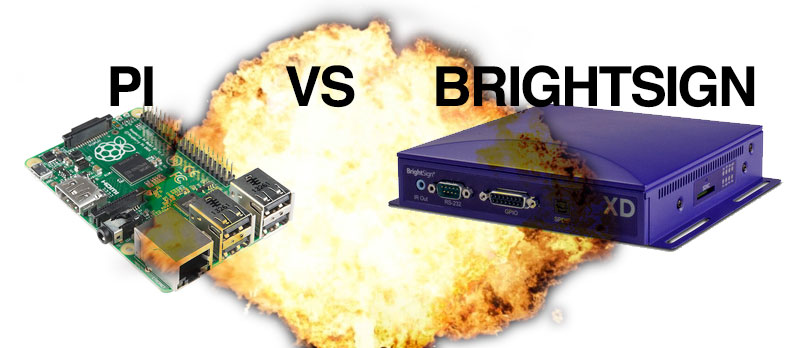 I have done much work with video installations, ranging from businesses to even inside private homes ! Today, however, I find myself faced with a dilemma. Whenever I am tasked with a video installation job, I question should this run off a Raspberry Pi or a BrightSign player?
I have done much work with video installations, ranging from businesses to even inside private homes ! Today, however, I find myself faced with a dilemma. Whenever I am tasked with a video installation job, I question should this run off a Raspberry Pi or a BrightSign player?
In the early 2000s I was introduced to BrightSign, which at the time was named Roku. They were, and still are, the industry standard for playing video. You will see these everywhere, from a BOSE audio demo at Best Buy, to the Jurassic Park exhibit at Universal. They truly are amazing pieces of hardware.
What is a BrightSign? In short, they are solid state media players with many models, offering a plethora of features from network capabilities to I/O support. From personal experience, I have never seen a single one fail. I have dropped them (not recommended), seen them doused in fire retardant (also not recommended) and they still continue to run for hours and hours to this day.
From the first time I made a light blink on my BASIC stamp 1, I have been in love with microcontrollers. Three years ago, the first Raspberry Pi (Microcomputer!) was released. "The Raspberry Pi is a series of credit card-sized single-board computers..."[1]. It was a huge advance in the hacker community & it was only $40.
Immediately after release, devs began making everything--one of those things being kiosk software. It was great for photo slideshows, but was not great for video. It was slow and missing the the feature I needed most--seamless looping video. Since then, the Raspberry Pi has been seriously upgraded. Devs have written much more efficient code. Seamless looping video is now a thing!
A Raspberry Pi is 20-45 USD , while BrightSign is 200-600 USD! But, if they both do the same thing, why would I bother with BrightSign?
Reliability
As stated before, I have beat the hell out of BrightSigns and they have never failed me once. In some installations they ran for weeks/months at a time without being shut off and there was zero effect on frame rate or quality. I cannot say the same for a Raspberry PI. I have had many issues with cards going corrupt, rebooting for no reason, and some issues with memory causing the frame rate to chug.
Ease of use
 Bright Author vs terminal?
Bright Author vs terminal?
The Raspberry Pi has a great deal of documentation behind it. Even so, if you have zero development background, there will be a very large learning curve. On the other side, BrightSign's Bright Author software was written for the average consumer. From creating just a simple video loop to button interactions, you will only need to spend minutes building your configuration file.
Who to choose
Today, BrightSign will still be my go to for client video installations. If I'm being paid to create an experience, I want that experience to work flawlessly for as long as it's needed, many times after many years. I would not feel comfortable using a Raspberry Pi in a client installation. In the near future, however, I see the Raspberry Pi taking BrightSign's place. More and more artists are making the switch and using them for production. For my personal projects I will experiment with the Pi. If the problems I faced become less of an issue, I will then make the switch permanent.
Tags: raspberry pi, installation, brightsign